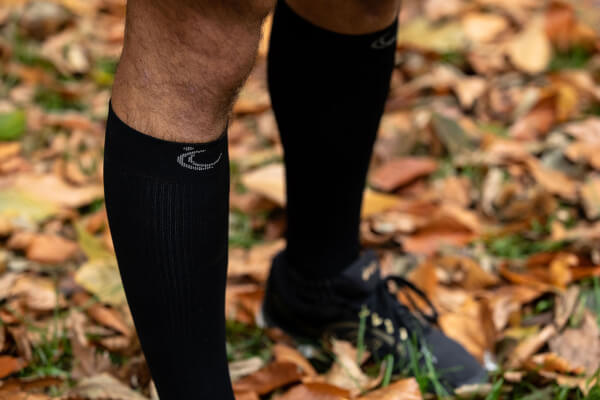Compression socks and compression stockings are not just for the elderly or infirm, they can be worn by people of all ages, of all professions, and from any walk of life to help improve circulation, reduce swelling and discomfort, and help prevent conditions like DVT and varicose veins. This guide will explore everything you need to know about compression stockings and socks, and what to look for to find the best compression socks for your needs.
What are compression socks and stockings and how do they work?
Compression socks and stockings are special garments designed to apply gentle pressure to your legs. This pressure is strongest at the ankle and gradually decreases as it moves up the leg towards the thigh. This graduated pressure helps improve blood circulation in the legs, delivering fresh, oxygenated blood around the body. In turn, this can help reduce swelling and the risk of developing conditions such as DVT or varicose veins. Compression wear can also help improve athletic performance, speed up recovery times and increase comfort when worn daily. This can be especially beneficial if you have a job spending a lot of time on your feet, such as medical professionals, childcare workers, and those with manual jobs which involve a lot of walking.
What types of compression socks and stockings are there?
There are two main types of compression socks and stockings:
- Medical compression stockings: Often prescribed by a doctor to treat medical conditions such as varicose veins, lymphedema, and deep vein thrombosis (DVT), these medical grade support stockings or socks come in different strengths, measured in millimetres of mercury (mmHg).
- General compression socks: These compression socks for men and women offer less compression and can be purchased without a prescription. They are often used by athletes, pregnant women, the elderly, frequent travellers, and people who sit or stand for long periods to help prevent leg fatigue, swelling, and blood clots.
What compression level to choose for compression stockings and socks?
Compression socks and stockings come in different levels of compression depending on your needs and any other factors to consider such as age, size and weight, ongoing health conditions, mobility and more. We recommend speaking to a medical or care professional to determine what level of compression you need, but the guide below will help you understand the differences.
- Low compression (under 18mmHg): Good for everyday wear, travel, or mild circulation issues. They’re often easy to find in general high-street shops and pharmacies. Our FITLEGs Everyday Life Compression Socks fall into this category.
- Medium compression (18-24mmHg): Ideal for those with minor to moderate varicose veins, swelling, or who want extra support during athletic activity or recovery. Explore our range of FITLEGs Sport Compression Socks at this level.
- High compression (24-35mmHg): Recommended for more serious conditions such as blood clots (DVT), varicose veins, severe swelling, or those recovering from surgery or injury. Explore our range of FITLEGS AES Medical Compression Socks for these. Some medical compression socks feature open toes for people with foot injuries, or grip soles for those with reduced mobility or confidence on their feet. You may also find that a medical professional will prescribe these compression stockings to you.
- Extra-firm compression (over 35mmHg): Usually reserved for people with severe vein problems or a history of blood clots, these compression socks and stockings will require a prescription from your doctor. People with high blood pressure or other circulation issues may not be able to safely wear compression stockings at this level.
Compression Socks vs Compression Stockings?
Choosing between compression socks, stockings, or leggings depends on what you need support for, how far up your leg the issue extends, and your personal preference. Compression socks, stockings and even leggings all come with pros and cons.
- Compression socks: Ending just below the knee, these target the ankles and calves, providing the most significant compression in those areas. They are ideal for everyday wear, foot pain, ankle swelling, minor varicose veins, and blood circulation issues. This length is often also used for sport compression socks as well as for flying.
- Compression stockings: These support stockings extend higher up the leg, typically reaching the mid or upper thigh. They offer graduated compression, which is strongest at the ankle and gradually decreases as it goes up. This is beneficial for conditions like moderate varicose veins, lymphedema, and blood clots. You may be recommended to wear these if you are recovering from an injury or operation, or have longer-term conditions.
- Compression leggings: These cover your entire leg, sometimes including the feet, and are worn like regular leggings. They can provide a range of compression levels and are suitable for athletic performance, recovery, or everyday comfort, especially if you experience aches, pains and discomfort.
Who should wear compression socks and stockings?
Compression socks and support stockings can and should be worn by a whole host of people. Whether you’re a nurse on your feet all day, a frequent flyer or someone who sits for long periods, a pregnant woman, a patient at risk of developing DVT or varicose veins, an athlete, or even someone who suffers from minor leg aches and pains, compression socks may be able to help.
If you’re unsure whether a compression sock or support stocking is right for you, or which compression level you need, don’t hesitate to contact us. Our expert team is always on hand to help and ensure you find what you need. Explore our range of compression socks for women and men at the FITLEGs shop.
